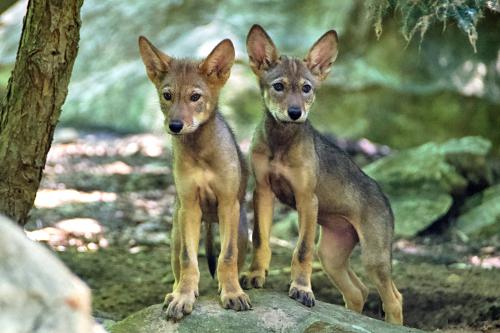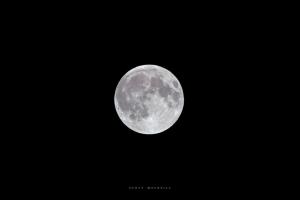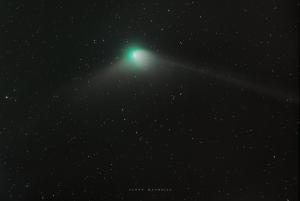Celebration of Space - January 19, 2024

Red wolf pups, which is not something you generally see in the wild. Image credit: ucumari photography
This coming Tuesday, January 23, 2024 at 4:30 pm, the Frosty Drew Memorial Fund will host the annual meeting of the Board of Directors. This is a chance for Frosty Drew to plan out our year. Topics of the meeting will include new projects and expansions of our operations, events for 2024, and an update and outlook of our five year plan. The annual meeting also allows us to reflect on how far we have come as an organization and the impacts that we have had on the region.
This coming Thursday, January 25, 2024 at 12:55 pm EST, yet again, the Moon will orbit into a position where it arrives on the opposite side of Earth than the Sun, which is called “opposition”, and more commonly known as the full Moon. During the full Moon the entire side of the Moon that is in direct sunlight faces Earth, with the other side of the Moon being in full night. On the day of the full Moon, the Moon will rise with the setting Sun, and set with the rising Sun, placing the Moon into the sky for the entire nighttime period.
Like all full Moons, the January Moon will have a name as well, and the moniker it generally goes by is the Full Wolf Moon. According to the Old Farmer’s Almanac, January was the time of the year that wolves would howl due to hunger in the winter months. Today we realize that it is not hunger that sparks the lovely song of the wolves, but instead those howls are methods of communication with the pack and other packs. In the US, perhaps we should take the name of the January Moon as a moment to think about the red wolves, which are native to only the Southeast United States.
The red wolf population became extinct in the wild in the mid-late 1900’s due to loss of land to human use, with only a couple hundred wolves existing in captivity. Beginning in the 1980’s, controlled releases of red wolves into the wild brought back the population to nearly 100 red wolves living in the wild. Sadly, changes in land laws in some of these regions in the mid 2000’s allowed landowners to shoot and poison the red wolves. Alongside vehicle strikes, and cross breeding with non-sterilized coyotes, populations in the wild dropped to seven radio-collared wolves. Since then, some of those laws have been reverted as they were found to violate the Endangered Species Act, and populations in the wild are slowly increasing, with still less than twenty wolves living in the wild. Note that Roger Williams Park Zoo has red wolves on display!
Other names of the January full Moon are the Severe Moon, Freeze Up Moon, Hard Moon, Great Moon, Canada Goose Moon, and the Spirit Moon. Regardless of what you call the January Moon, seeing it rise will be a beautiful sight. So set out to a location with a good view of the east horizon, and be there for the 4:30 pm EST to catch the full Moon rising about 10 minutes later.
Over the past couple of years we have had some media-happy comets passing through the inner Solar System, but as for actual viewing, they were pretty poor and not all that noteworthy. Skip ahead to early autumn 2024 and we just may have a comet worth writing about. The comet is C/2023 A3 Tsuchinshan-ATLAS (A3). It was discovered a year ago, and it has been predicted to potentially become visible to the naked eye. A prediction that usually doesn’t happen, but we can hope.
Comet A3 is a long period comet, which means it has an orbital period of over 200 years. The comet originated from the Oort Cloud, which is the very edge of the Solar System, and has an orbital period of 80,660 years. This may be the first time the comet has approached the Sun, which certainly bodes well for naked eye visibility. The comet will make its perihelion transit on September 28, 2024, which is when it will pass closest to the Sun, at a distance of 36,295,282 miles from the Sun. Then on October 13, 2024, the comet will swing past Earth at a distance of 44,258,636 miles. This puts the comet at best viewing during the weeks of October 14 - 24, 2024.
We still have several months before we get a good idea of how bright the comet will become, but any prospect of a naked eye comet is exciting! So keep an eye out for any news about Comet A3, and we will frequently write updates on the comet’s evolution as it approaches perihelion. So keep your fingers crossed!
Last week, both the International Space Station (ISS) and China’s Tiangong station became visible over the US in the evening hours, and offered up stunning pass sightings over our region. Well both stations continue to pass over during the evening hours daily, and will allow for a few more viewing opportunities this weekend and coming week. Here are several notable pass times for our region:
ISS:
Fri, Jan 19 at 6:15 pm, starting in the W, rising to 26°, heading towards the N, and into orbital sunset
Sat, Jan 20 at 5:27 pm, starting in the W, rising to 37°, heading towards the E
Mon, Jan 22 at 5:28 pm, starting in the WNW, rising to 21°, heading towards the NNE
Tiangong:
Fri, Jan 19 at 6:03 pm, starting in the W, rising to 44°, heading towards the SE, and into orbital sunset
Sun, Jan 21 at 5:38 pm, starting in the W, rising to 29°, heading towards the SE
Even though this week’s passes are not all that fantastic, the stations will still be visible. This week will also be the last evening passes of Tiangong for the current pass cycle, which will return to the evening sky in late February. Evening passes of the ISS will continue until February 4th. For daily pass times of these stations and other bright satellites, visit the Frosty Drew Daily Satellite Pass Prediction Utility.
- Author:
- Scott MacNeill
- Entry Date:
- Jan 19, 2024
- Published Under:
- Scott MacNeill's Columns




